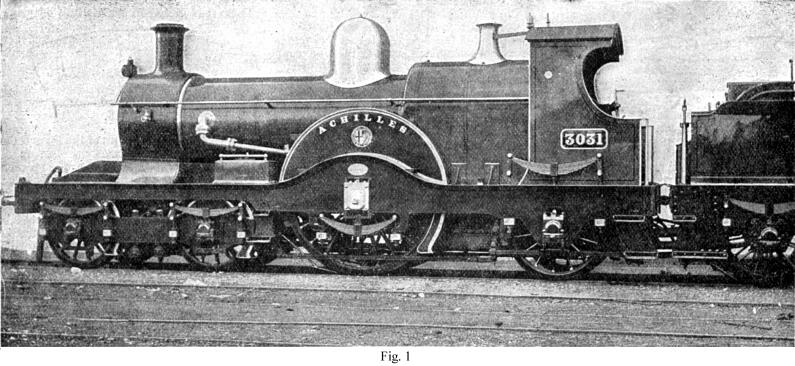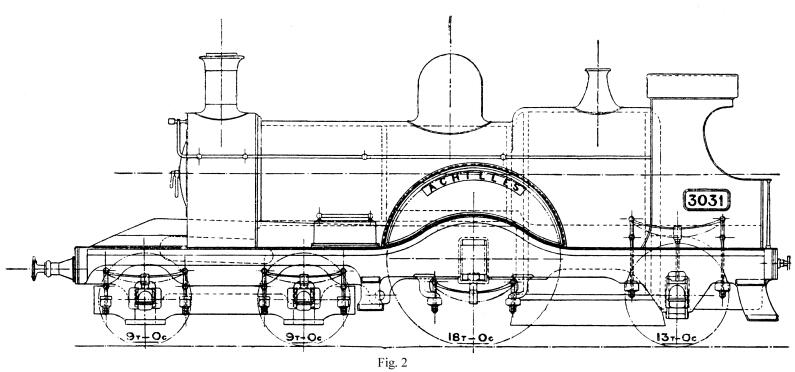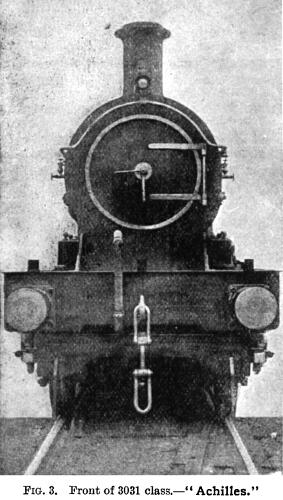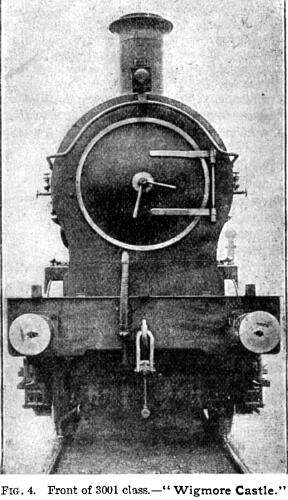SOME NEW GREAT WESTERN ENGINES.
By the Rev. A. H. MALAN, M.A.
September 8, 1894
(Illustrated with Photographs by the Author.)
THERE are now being turned out at Swindon thirty single-wheel
engines having every prospect of rendering good service on the
road, possessing, as they do, all the merits of the previous thirty
without their defects.

Poor things! the 3001 class made their appearance at an awkward
time—for them. They found themselves called upon to supersede
time-honoured express engines of wide base, excessive heating-surface,
and noble outline, and expected to emulate the achievements of
these without tuning a hair, or, in other words, straining a bolt.
A certain degree of prejudice against the newcomers was naturally
to be looked for on the part of admirers of the broad-gauge "
eight feet " with all their admirable qualities. At the first
glimpse, the imperishable words of "Henry's First" came
to mind—figura habet nihil stabilitatis; and the worst
of it was that, as time went on, it did not appear as if such
prejudice was unjustified. However, there is no need to repeat
what has been said elsewhere; [* "Round the Works of our
Great Railways." 1893.] while it would be extremely ungracious
to perpetuate the peccadilloes of individuals which have now realised
the error of their ways and are turning over a new leaf.
The "Wigmore Castle" was the first to reform, and return
to duty as a converted character. After its mishap at Box, when
it collapsed at an irregular curve made by itself or by others
of that ilk, it retired from the scene, reviewed the situation,
protruded its framing forwards, evolved a bogie truck, and reduced
its 20-inch cylinders by an inch. Trial trips proving eminently
satisfactory, thirty engines with similar features were at once
put in hand, while the other twenty-nine of the "Wigmore
Castle" class are to be altered as circumstances permit.

At a recent "private view," kindly accorded me by
Mr. Dean, the "Achilles," first of the new series, was
found to be having the finishing touches put to it, before being
dismissed on its travels with a blessing. Its springs were being
adjusted in a highly practical and simple manner. One or two good,
honest iron nits having been placed at intervals along one rail,
the engine would be slowly run over them, the wheels crunching
up upon the nuts, and falling off, with a resounding, but harmless
bump; clearly showing that this Achilles is not vulnerable
in his heels. The sudden jolt and extra pressure on any one spring
takes some of the stiffness out of its joints; and thereby the
weight of the engine is distributed in more just proportion.
 Watching this performance being
repeated several times, one recollected how, as schoolboys, we
used, of a half-holiday—I fear, without even permission "to
go on the line"—to put halfpennies (pennies being too
great a sacrifice), in the track of a train, and then, as the
engine dashed past, wasted the fears of our guilty consciences
by sudden dread lest the coin might send it off the rail!
Drivers, in those days, had a mysterious tap somewhere at their
command, from which they dearly loved to eject steam and water,
in a continuous jet, at about the level of our white collars;
taking very good care to turn on the spray before they passed
the trespassers, so as not to miss their aim. And for all one
knows, the same trick may be performed at the same place, even
now. Watching this performance being
repeated several times, one recollected how, as schoolboys, we
used, of a half-holiday—I fear, without even permission "to
go on the line"—to put halfpennies (pennies being too
great a sacrifice), in the track of a train, and then, as the
engine dashed past, wasted the fears of our guilty consciences
by sudden dread lest the coin might send it off the rail!
Drivers, in those days, had a mysterious tap somewhere at their
command, from which they dearly loved to eject steam and water,
in a continuous jet, at about the level of our white collars;
taking very good care to turn on the spray before they passed
the trespassers, so as not to miss their aim. And for all one
knows, the same trick may be performed at the same place, even
now.
But to return. The "Achilles" having nothing more
particular to do that afternoon than run about in the yard and
exercise its machinery, a photograph of it was desirable, and,
with this object in view, after sundry tenders, blocking the way,
had been removed, it arrived at last on the line—next to
a dead wall, with high, distempered, canvas facing. This "studio"
proved much too short for its great length; but, on the whole,
that seemed a pardonable blemish, as likely to seal its doom more
quickly. For, by a strange unfitness of things, the studio is
situated almost directly below the stack of the foundry blast
furnace; and it so happened that the wind was blowing the sulphurous
fumes straight down upon the engine. Hence it was not surprising
to hear that the official photographers prefer another background
elsewhere. The Greek stories are fond of narrating how, when mortals
were worrying some hero, the gods would envelop him in a mist;
and just now there was a plain demonstration of the very phenomenon.
When an interval of comparative clearness was obtained, a yellow
screen was used with an isochromatic plate; but the screen was
not of much service, after all, the half-tones proving to be neither
better nor worse than in another negative taken without it. But
undoubtedly isochromatic plates are far better for such subjects
than ordinary plates; as, indeed, they are for nearly all other
subjects as well.
To borrow a nautical phrase, the, engine "sits" the
rail well; the framing looks less common and hopelessly angular
than before; a front view shows all outward signs of top heaviness
to have been eliminated by the additional wheel, well in advance
of the buffers. There is a certain amount of ornamentation, too,
that seems quite in keeping with a class destined to bear such
titles as "Majestic," "Dreadnought," etc.
For instance, the arms of the Company are no longer in flat transfer,
but cast in relief and hand-painted; and the name letters are
shown off against black lacquer. But the arms seem too crowded
in, laid the brass letters are too near the brass splasher-bead
for a good effect.
 But how paltry seems that splasher-bead,
as compared with the embellishments of the past! The intrinsic
value of the brass in the "Great Britain's" two splashers
(one of which still survives, and may be seen surmounting some
name-plates in a Cornish vicarage) was over six pounds. But how paltry seems that splasher-bead,
as compared with the embellishments of the past! The intrinsic
value of the brass in the "Great Britain's" two splashers
(one of which still survives, and may be seen surmounting some
name-plates in a Cornish vicarage) was over six pounds.
An outsider can suggest anything he likes, because his advice
is not in the least likely to be taken; and therefore the remark
can be hazarded that the name might with advantage be placed midway
between the splasher and framing, and embellished with a little
scroll-ornamentation in brass—i.e. something after
the style of the name of a passenger steamer, only not so "loud."
The arms might then be removed to where the number now stands;
and the number, in smaller letters, be placed below it, or relegated
to the buffer beam, or some odd corner. The broad-gauge thirty,
be it remembered, were never numbered; but then, they were
not items in the thousands, but sui generis!
The bogie, one learns, is no one's patent; it has "grown."
Would that it could have grown a bit wider during its evolution!
But the narrow-gauge demands that the cylinders and bogie-bearings,
etc., should pack themselves within such confined limits that
it is a work of real nicety to get at the details. Let us hope
that no member of the 3031 class may come to grief, except where
a pit is handy. Why, the other day, a driver of an engine of another
class, crept into the "works " of his bogie, and to!
there the fore part of him stuck fast ! A pretty position for
a man to find himself in, especially if his train was just signalled!
One uses that term "narrow " gauge, because the usual
expression "national gauge" seems almost to imply that
the nation has something to be proud of, which is by no means
the case. But the term is admissible, after all, for one broad-gauge
engine may still be seen running in Swindon yard. This is a travelling
crane, which is kept at work, and the third rail kept to work
it, because it can do more duty than ordinary cranes, and need,
no cramping of its wheels to the rail lest it should tip over.
Narrow-gauge advocates, please observe!
It is good to see the big single driving-wheel still retained.
With a fair load, nothing can beat the motion of a single-wheel
engine; and it may not be all fancy that seems to detect a difference
in the momentum and pulsating vibration of a railway carriage
at a high speed, according to whether a single-wheel or coupled
engine is attached. But it is a serious problem with heavy loads
to get enough tractive power out of one pair of wheels, so as
to keep time, without so weighting them as to strain the gear.
In addition to not exhausting their steam quick enough, it was
in this direction that the 3001's proved a little too energetic;
on which account their cylinders are being reduced, and a ton
taken off the burden of their "drivers." But, while
referring to them, it is only just to say that the pitching and
rolling for which they have been rather notorious would not have
been so bad if 5-inch bullhead rails and well-packed transverse
sleepers had been general; it being, a difficult thing to keep
3-inch bridge rails quite true—as between themselves—when
supported by longitudinal baulks. On the broad gauge, the wide
base annulled any small irregularity, but the narrow gauge has
but little margin of stability.
Experiments, it is asserted, are being held somewhere towards
making electricity an adjunct to the high-pressure locomotive,
by utilising the waste power of the crank-shaft to create a current
applicable to the other wheels; rendering them thereby auxiliary
driving-wheels. Such an additional grip, if it should prove workable,
would at once permit increased loads and greater speed, besides
being of material help in mounting banks. But the time for this
innovation has not yet arrived; there may be counteracting objections
to the idea; but at any rate the "Achilles" class (so
ably set out in the reproduced official diagram) will serve well
enough for some years to come. And it can be safely predicted
that the " Stormy Petrel," "Voltigeur," "
Behemoth," "Devonia" [why not "Lyonesse"
and "Cornubia"?], etc., will not require to put in an
appearance at the repairing sheds more frequently than any
well-disposed engine, of robust physique and average vitality,
would feel itself amply justified in doing. We heartily wish them
well.
Stories Page
| Contents Page
|







